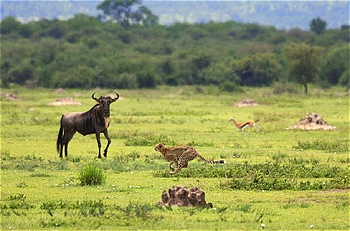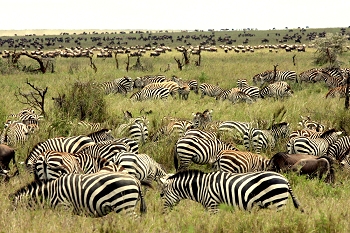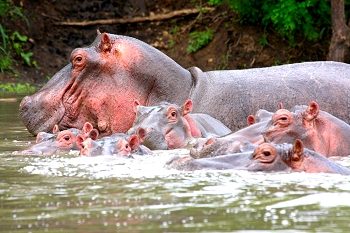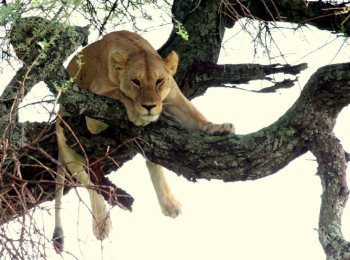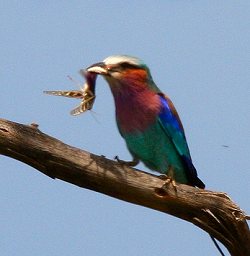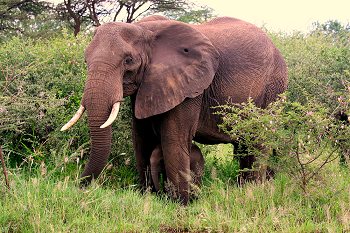- You are here
- Home
- Guide to Africa
- African Travel Articles
- Out of Africa (And Back Again and Again…)
Out of Africa (And Back Again and Again…)
Parent page
Written by Steve Brynes - The Safari Advisor
There is this thing called mal d'Afrique, an indefinable feeling of loss that compels visitors to return to Africa time and again. A state of mind actually, it is nevertheless real and infectious.
Serengeti PlainsTheories about the cause abound: it is a taste for dust; it is the alteration of one's vision, becoming preoccupied with distance, far horizons, the sense that you've stepped into a place of endless pristine wilderness; it is the feeling of detachment, your spirit telling you you've found a place to linger; or maybe it is your inner being recognizing the birthplace of its origin.
One thing is certain: much like the common cold, there is no cure and the best you can do is treat the symptoms. And, so it was that, seeking some relief, I headed to Tanzania for a first-time visit to the Serengeti.
The excitement of returning to Africa notwithstanding, a trace of uncertainty hung over me as the twin-engine, 18-seat plane (known as the 'bus' by safari camp workers) from Arusha, Tanzania's 'safari capital,' made its way to my first stop. I fretted that the Serengeti, a fixture on most everyone's "Places to Visit in a Lifetime" list and the subject of countless television documentaries, might not live up to all the hype.
Serengeti Zebras and WildebeestAs the plane banked hard to begin its alignment with the airstrip's dirt runway, I gazed down on the vast plain. The mid-morning sun sparkled in pinpoints off the plain, a sure indication that the heavy rains of November recently had flooded this area of the Serengeti. Nevertheless, beside the airstrip a small herd of giraffes languorously strode among nearby trees, grazing on leaves, and beyond them, the odd wildebeest stood impassively. These sights were the salve for my long-raging case of mal d'Afrique, and I grew confident that the Serengeti, home to the largest mass of free-ranging animals on earth, would, in fact, be all it's touted to be.
After deplaning, I was directed to a car for a short hop to the Grumeti River Lodge, a tented camp tucked away in a remote valley in the western corridor of the Serengeti. Those who have yet to visit Africa are advised to forget whatever association camping brings to mind. This is something quite different. Although it offers only canvas walls (and at the same time all the varied magical and romantic sounds of the African bush), Grumeti in all other ways proves luxurious. Consisting of 10 spacious tents on raised concrete platforms set under makuti (palm frond) canopies, Grumeti Camp provides discreetly separated tents, each with a well furnished deck and interior, king-sized bed, overhead fan, electric lights, ensuite bathroom with hand basin, flush toilet and al fresco shower open to the stars and the occasional curious vervet monkey.
Hippos in SerengetiBut best of all, the camp abuts a pool that supports a resident pod of Hippos and casts an atmosphere of sheer in-your-face Africa. So while the manager advised me of the camp rules upon my arrival, the most important being never, ever leaving your tent after dark without a staff escort, the hippos serenaded with a cacophonous chorus of snorts/grunts/bellows and harrumphs.
Safari camps are nothing if not ultra efficient, and after the recitation of the ground rules I was told to grab my photo gear, to not worry about my bags and to hustle to a vehicle that would catch me up with a game drive already in progress.
Within minutes we spotted an idling Land Cruiser that held a middle-aged couple who appeared, from a distance, to be involved in some odd religious rite as they flogged themselves with horse tail swatters. After hopping into the new vehicle, sitting down, and immediately sensing pricks through my clothing, I realized they were gamely trying to ward off tsetses, those nasty biting flies that have retained their modern morphological form for about 34 million years.
Following introductions all around, Waziri, the driver and guide, posed the question guides will ask all new visitors prior to their first game drive, "What do you wish to see?"
"Big cats, and after that, everything else," I replied. With that, we moved off. A short time later, Waziri, stopped and said, "I see a cheetah sitting in the grass far off on the plain. Let's go near and observe." We approached within 20 yards of the Cheetah, a beautiful female, who paid us little attention, her gaze focused on a not-too-distant pack of gazelles. Waziri began to speak, first in hushed tones then in an increasingly excited and dramatic manner, much like an announcer of a thoroughbred horse race. "Look at this beautiful animal. See how she stares at the gazelles. If we continue to watch perhaps we will see a hunt."
"She is rising, look at how she is holding her body and beginning to stalk the gazelle. She must get within about 50 yards of its prey to have a good chance at a kill, but she is still about 100 yards away, now 70 yards away, still too far."
"But look! She is starting to trot; the gazelle see her and are moving away. There, she is going to full speed now, maybe 100 kilometers per hour! She was too far away, but still she is passing some members of the pack, she is focused on a very young gazelle. No, she will not catch the young one; she is stopping, giving up the hunt!"
We all sat back, winded, most likely from holding our breath, but winded all the same, as if we had been chasing prey. "Let's have a look," Waziri said.
We pulled up within 5 yards of the cheetah. She sat on her haunches, her chest heaving as she took huge gulps of air. Waziri explained that although cheetahs can attain terrific speeds within a short time (standstill to top speed in an astounding 3 seconds), they do not have the stamina to go more than 200-300 yards at that pace.
Lion in TreeAt dinner that night, an excellent four-course affair held in a boma (a traditional enclosure under the stars), Waziri said he wanted to show us some Zebra and to expect an all-day game drive the next day. Our destination would be the Seronera, located in the heart of the Serengeti. An all-day drive was a departure from the usual game-drive routine of a three-hour early-morning drive and a late-afternoon drive that usually lasts past sunset, and I wondered what Waziri had up his sleeve.
The distance from the Grumeti Lodge to the Seronera is about 100 km, or 60 miles. But given the rutted, slippery condition of the road (again, it was November, Tanzania's short rainy season), that distance requires about 3 hours of driving.
The roads of the Serengeti, truthfully, do not make for comfortable rides despite the robustness of safari vehicles. On a typical drive, you will be jostled, hurled, thumped and lurched to each of the four directions of the compass and all points in between.
Giraffe in SerengetiBut any thoughts of discomfort evaporate instantly when presented with an interesting sight, which luckily happens on a continual basis. So along the way to the Seronera, we were diverted by the occasional warthog darting across the road from tall grass followed moments later by a skittering handful of piglets; by a strikingly beautiful Black-and-White Colobus monkey sitting practically shoulder to shoulder with hawks high atop a tree along the Grumeti River; by groups of various species of Africa's supreme scavengers, vultures, bickering among themselves and intermittently putting on a fairly impressive show by spreading their enormous wings; and by families of giraffes who, although they preferred the road, yielded only when they realized the Land Cruiser wouldn't.
We finally arrived at the western end of the Seronera, and the Serengeti became a tapestry of wildlife spectacles, both large and small. On retrospect, it almost seemed that we sat still and scenes moved past us: a riverine glade populated with a herd of zebra, mixed in with Giraffes and wildebeest; Lions lounging in trees, a mother Elephant standing directly over her baby, fitting as snugly as Russian nested dolls; a spectacularly-colored lilac-breasted roller sitting on a tree limb trying to figure out how to swallow an enormous grass-hopper it had firmly clamped in its beak; and finally, what turned out to be the ace up Waziri's sleeve, the tail end of the great migration, the largest movement of wildlife on earth as up to 2 million wildebeest and zebra, in pursuit of food and water, rotate between the Serengeti and the adjoining Masai Mara Reserve in Kenya.
Roller in SerengetiReturning from the Seronera, the dark gray clouds to the west portended heavy rains at the Grumeti Camp and as we proceeded both the road and the surrounding plains evidenced signs of flooding. Three kilometers from the camp, it is necessary to cross the Grumeti River. There is no bridge perse; instead the dirt road here has been replaced by concrete and the vehicle crosses the river which normally streams gently over the concrete.
As we approached the crossing, it was clear that things had changed dramatically from earlier in the day. The crossing then was easy and we had paused to grudgingly admire the huge crocodile, toothy and glazed-eyed, that floated nearby in a pool on the downriver side. Now water rushed over the concrete at an alarming height and rate, and we all knew what awaited us should the vehicle be swept into the river.
Waziri left the vehicle to better assess the height of the flow, the ground clearance of the Land Cruiser and our chances of safely getting to the other side. "Waziri," I said, "I guess it's important that the water doesn't float the vehicle." "I'm not as worried about not floating, as not dying," he replied. Who could argue with that kind of bottom-line thinking?
Elephant in SerengetiHaving made his decision, Waziri jumped on board and slowly inched the safari vehicle forward. The vehicle held firm and moved straight on, with no sideways motion detectable. Sighs of relief were audible. This finale to the game drive, it seemed certain, would only embellish future memories; after all, the appreciation of a thing is heightened by a touch of danger.
Five days later, after subsequent visits to the northern Serengeti and the Ngorongoro Crater, I was jetting home from Arusha to Washington, DC. The 28-hour return afforded time to reflect on Africa's vastness and remoteness, its abundance and variety of birds, animals, plants and flowers-and much more than enough time to feel a familiar growing emptiness in the heart.
